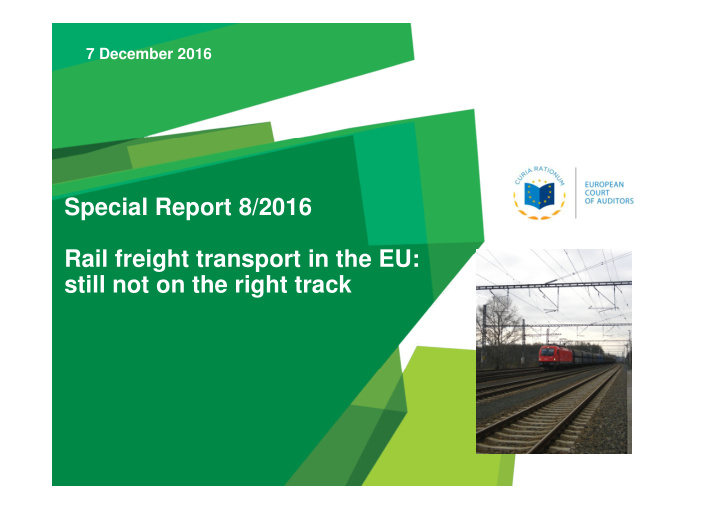



7 December 2016 Special Report 8/2016 Rail freight transport in the EU: still not on the right track
Table of contents � Why the subject matters � The questions we asked � What we found � What we recommend � Other Special Reports and Opinion Page 2
Why the subject matters (1/2) Source: ECA based on European Environment Agency 2012 data for the EU Page 3
Why the subject matters (2/2) � The mobility of goods is essential for the EU internal market, growth and jobs creation � BUT can have negative impacts on environment and quality of life of EU citizens Increasing rail freight would contribute to reducing pollution and congestion: � Shifting freight from road to rail is an EU transport policy objective � Funding for rail infrastructure: €28bn allocated during the period 2007-2013 Page 4
The questions we asked Are EU actions effective in enhancing rail freight transport? - Has the performance improved since 2000? - Strategic and regulatory framework? - EU funds properly targeted? � Five Member States: Spain, France, Germany, Czech Republic and Poland � 18 rail infrastructure projects selected accounting for a total EU contribution of €2bn Page 5
What we found Rail freight transport performance (1/2) � The performance of rail freight transport remains unsatisfactory overall: the objective of shifting goods from road to rail not reached � Road remains the leading mode of freight transport in the EU � Poor performance of rail freight transport not helped by low speed of trains Page 6
Rail freight transport performance (2/2) � BUT, some Member States have managed to increase the proportion of goods transported by rail, including one of the Member States we visited - Germany, due to: � its central location and high level of industry � the early liberalisation of its rail freight market � the introduction of a road toll for heavy vehicles � its relatively strong and independent regulatory body Page 7
Strategic and regulatory framework (1/2) � Many strategic and regulatory factors prevent rail freight from being more competitive Some efforts by the Commission, BUT : � A single European railway area is still far from being achieved – system of 26 separate national networks, interoperability issues (ERTMS) � Uneven progress of rail freight market liberalisation in Member States – still significant market share of incumbent freight operators Page 8
Strategic and regulatory framework (2/2) � Traffic management procedures are not adapted to rail freight needs (path allocation) � Unlike rail, road infrastructure is not always subject to charges for every kilometre used � Administrative and technical constraints hamper the competitiveness of rail freight (4 th railway package) � Lack of transparency on the performance of the sector has not stimulated improvements in customer service Page 9
EU financial support � EU funding has not properly targeted the needs of the rail freight sector: � Overall more EU funds were allocated to roads than to rail… � …when allocated to rail, EU funds did not specifically target rail freight needs � Co-financed projects: outputs delivered, but no general improvement in rail freight performance � Poor maintenance of lines used mainly by freight trains affects performance of EU-funded infrastructure Page 10
What we recommend (1/3) EC and the MS should make the rail freight more competitive and attractive by: � Addressing the strategic and regulatory issues (Recommendations 1 to 5) � 1: Ensure that national regulatory bodies have the power and independence they need, in particular to prevent anti-competitive practices � 2: Adapt the traffic management rules to the needs of the rail freight sector Page 11
What we recommend (2/3) � 3: Simplify and harmonise procedures for vehicle approval and for safety certificates, and simplify the language requirements for train drivers � 4: Monitor progress and evaluate user satisfaction to promote good quality service � 5: Promote a level playing field between the different methods of transport Page 12
What we recommend (3/3) � Better targeting the available EU funding (Recommendations 6 to 8) � 6: Allocate EU funding in line with EU transport policy objectives and monitor how much EU funding is actually invested into rail freight � 7: Improve the coordination of rail investments to maximise their effectiveness and avoid development in a piecemeal fashion � 8: Ensure proper maintenance of the rail network, in particular rail freight corridors Page 13
Other Special Reports and Opinion (1/2) � SR 31/2016 Spending at least one euro in every five from the EU budget on climate action: ambitious work underway, but at serious risk of falling short � SR 23/2016 Maritime transport in the EU: in troubled waters - much ineffective and unsustainable investment � SR 1/2015 Inland Waterway Transport in Europe: No significant improvements in modal share and navigability conditions since 2001 � SR 21/2014 EU-funded airport infrastructures: poor value for money Page 14
Other Special Reports and Opinion (2/2) � SR 1/2014 Effectiveness of EU-supported public urban transport projects � SR 5/2013 Are EU Cohesion Policy funds well spent on roads? � SR 1/2013 Have the Marco Polo programmes been effective in shifting traffic off the road? � Opinion 2/2016 EFSI: an early proposal to extend and expand Page 15
Thank you
Recommend
More recommend